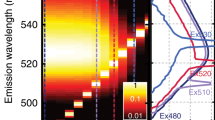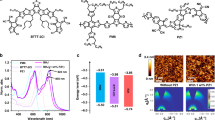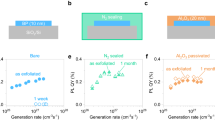Abstract
Polymer light-emitting diodes (PLEDs) are attractive for use in large-area displays and lighting panels, but their limited stability under current stress impedes commercialization. In spite of large efforts over the last two decades a fundamental understanding of the degradation mechanisms has not been accomplished. Here we demonstrate that the voltage drift of a PLED driven at constant current is caused by the formation of hole traps, which leads to additional non-radiative recombination between free electrons and trapped holes. The observed trap formation rate is consistent with exciton-free hole interactions as the main mechanism behind PLED degradation, enabling us to unify the degradation behaviour of various poly(p-phenylene) derivatives. The knowledge that hole trap formation is the cause of PLED degradation means that we can suppress the negative effect of hole traps on voltage and efficiency by blending the light-emitting polymer with a large-bandgap semiconductor. Owing to trap-dilution these blended PLEDs show unprecedented stability.
This is a preview of subscription content, access via your institution
Access options
Access Nature and 54 other Nature Portfolio journals
Get Nature+, our best-value online-access subscription
$29.99 / 30 days
cancel any time
Subscribe to this journal
Receive 12 print issues and online access
$259.00 per year
only $21.58 per issue
Buy this article
- Purchase on Springer Link
- Instant access to full article PDF
Prices may be subject to local taxes which are calculated during checkout





Similar content being viewed by others
References
Burroughes, J. et al. Light-emitting-diodes based on conjugated polymers. Nature 347, 539–541 (1990).
Parker, I. D., Cao, Y. & Yang, C. Y. Lifetime and degradation effects in polymer light-emitting diodes. J. Appl. Phys. 85, 2441–2447 (1999).
Silvestre, G. C. M., Johnson, M. T., Giraldo, A. & Shannon, J. M. Light degradation and voltage drift in polymer light-emitting diodes. Appl. Phys. Lett. 78, 1619–1621 (2001).
Stegmaier, K. et al. Influence of electrical fatique on hole transport in poly(p-phenylenevinylene)-based organic light-emitting diodes. J. Appl. Phys. 110, 034507 (2011).
Gassmann, A. et al. Study of electrical fatigue by defect engineering in organic light-emitting diodes. Mater. Sci. Eng. B 192, 26–51 (2015).
Scholz, S., Kondakov, D., Lüssem, B. & Leo, K. Degradation mechanisms and reactions in organic light-emitting diodes. Chem. Rev. 115, 8449–8503 (2015).
Kuik, M. et al. Charge transport and recombination in polymer light-emitting diodes. Adv. Mater. 26, 512–531 (2014).
Niu, Q., Wetzelaer, G. A. H., Blom, P. W. M. & Crăciun, N. I. Modeling of electrical characteristics of degraded polymer light-emitting diodes. Adv. Electr. Mater. 1600103 (2016).
Spreitzer, H. et al. Soluble phenyl-substituted PPVs-new materials for highly efficient polymer LEDs. Adv. Mater. 10, 1340–1343 (1998).
Yoshioka, T. et al. An improved method for lifetime prediction based on decoupling of the Joule self-heating effect from Coulombic degradation in accelerated aging tests of OLEDs. SID Symp. Dig. Tech. Pap. 45, 642–645 (2014).
Yang, L., Wei, B. & Zhang, J. Transient thermal characterization of organic light-emitting diodes. Semicond. Sci. Technol. 27, 105011 (2012).
Lampert, M. A. & Mark, P. Current Injection in Solids (Academic, New York, 1970).
Giebink, N. C. et al. Intrinsic luminance loss in phosphorescent small-molecule organic light-emitting diodes due to bimolecular annihilation reactions. J. Appl. Phys. 103, 044509 (2008).
Schmidt, T. D., Jäger, L., Noguchi, L., Ishii, H. & Brütting, W. Analyzing degradation effects of organic light-emitting diodes via transient optical and electrical measurements. J. Appl. Phys. 117, 215502 (2015).
Wild, W., Seilmeier, A., Gottfried, N. H. & Kaiser, W. Ultrafast investigations of vibrationally hot molecules after internal conversion in solution. Chem. Phys. Lett. 119, 259–263 (1985).
Nakashima, N. & Yoshihara, K. Role of hot molecules formed by internal conversion in UV single-photon and multiphoton chemistry. J. Phys. Chem. 93, 7763–7771 (1989).
Langevin, P. Sur la loi de recombination des ions. Ann. Chim. Phys. 28, 443–530 (1903).
Rörich, I., Mikhnenko, O. V., Gehrig, D., Blom, P. W. M. & Crăciun, N. I. Influence of energetic disorder on exciton lifetime and photoluminescence efficiency in conjugated polymers. J. Phys. Chem. B 121, 1405–1412 (2017).
Abbaszadeh, D. et al. Elimination of charge carrier trapping in diluted semiconductors. Nat. Mater. 15, 628–633 (2016).
Acknowledgements
Parts of the text and results reported in this work have been reproduced from the thesis of Q.N., at the Johannes Gutenberg University Mainz, and accessible at https://publications.ub.uni-mainz.de/theses/frontdoor.php?source_opus=100001527&la=en. We thank C. Bauer, F. Keller and H. Raich for technical support. We acknowledge financial support from BASF SE.
Author information
Authors and Affiliations
Contributions
P.W.M.B. proposed the project, N.I.C. supervised the project. Q.N. and R.R. carried out experiments, G.-J.A.H.W. analysed the transport data, Q.N., N.I.C. and P.W.M.B. wrote the manuscript.
Corresponding author
Ethics declarations
Competing interests
The authors declare no competing interests.
Additional information
Publisher’s note: Springer Nature remains neutral with regard to jurisdictional claims in published maps and institutional affiliations.
Supplementary information
Supplementary Information
Supplementary Sections 1–13, Supplementary Figures 1–10, Supplementary references
Rights and permissions
About this article
Cite this article
Niu, Q., Rohloff, R., Wetzelaer, GJ.A.H. et al. Hole trap formation in polymer light-emitting diodes under current stress. Nature Mater 17, 557–562 (2018). https://doi.org/10.1038/s41563-018-0057-x
Received:
Accepted:
Published:
Issue Date:
DOI: https://doi.org/10.1038/s41563-018-0057-x
This article is cited by
-
Resolving electron and hole transport properties in semiconductor materials by constant light-induced magneto transport
Nature Communications (2024)
-
Switchable interfacial reaction enables bright and stable deep-red perovskite light-emitting diodes
Nature Photonics (2024)
-
Elimination of charge-carrier trapping by molecular design
Nature Materials (2023)
-
Solution-processed green and blue quantum-dot light-emitting diodes with eliminated charge leakage
Nature Photonics (2022)
-
Development of polymeric active layer for RGB light-emitting devices: a review
Journal of Materials Science: Materials in Electronics (2020)



